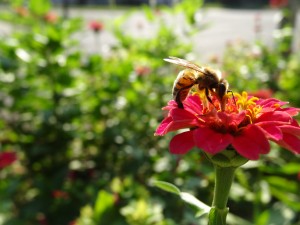21
Aug
Bee-Toxic Neonicotinoids Found in Nearly Half of U.S. Streams
(Beyond Pesticides, August 21, 2015) Neonicotinoid insecticides contaminate over half of urban and agricultural streams across the United States and Puerto Rico, according to a study released earlier this week by the U.S. Geographical Survey (USGS). Neonicotinoids (neonics) are bee-toxic insecticides that have been linked to the global decline in bee populations by a large body of science.
 The study, titled “First national-scale reconnaissance of neonicotinoid insecticides in streams across the USA” and published in Environmental Chemistry, was conducted from 2011 to 2014 and spans 24 states and Puerto Rico. Researchers found that at least one of the six neonicotinoids tested by USGS researchers was found in more than half of the sampled streams. Detections of the six neonicotinoids varied: imidacloprid was found in 37 percent of the samples in the national study, clothianidin in 24 percent, thiamethoxam in 21 percent, dinotefuran in 13 percent, acetamiprid in 3 percent, and thiacloprid was not detected. Both urban and agricultural uses contributed to neonic concentrations in streams, with imidacloprid occurrence significantly related to the amount of urban land-use and clothianidin and thiamethoxam significantly related to the amount of cultivated crop.
The study, titled “First national-scale reconnaissance of neonicotinoid insecticides in streams across the USA” and published in Environmental Chemistry, was conducted from 2011 to 2014 and spans 24 states and Puerto Rico. Researchers found that at least one of the six neonicotinoids tested by USGS researchers was found in more than half of the sampled streams. Detections of the six neonicotinoids varied: imidacloprid was found in 37 percent of the samples in the national study, clothianidin in 24 percent, thiamethoxam in 21 percent, dinotefuran in 13 percent, acetamiprid in 3 percent, and thiacloprid was not detected. Both urban and agricultural uses contributed to neonic concentrations in streams, with imidacloprid occurrence significantly related to the amount of urban land-use and clothianidin and thiamethoxam significantly related to the amount of cultivated crop.
“In the study, neonicotinoids occurred throughout the year in urban streams while pulses of neonicotinoids were typical in agricultural streams during crop planting season,” said USGS research chemist Michelle Hladik, Ph.D., the report’s lead author, in a press release.
“The occurrence of low levels in streams throughout the year supports the need for future research on the potential impacts of neonicotinoids on aquatic life and terrestrial animals that rely on aquatic life,” added USGS scientist Kathryn Kuivila, Ph.D., the research team leader. “These results will serve as an important baseline for that future work.”
The recent study expands on a previous USGS report that found the chemicals to contaminate Midwest waterways.
Neonicotinoids have become the fastest growing class of insecticides in agriculture. They are now the most widely-used class of insecticide chemicals and are registered in more than 120 countries. Studies continue to question the efficacy of these chemicals in pest control, showing no yield increases as a result of their use. Beyond food production, neonics are frequently detected in nursery plants sold at big box home and garden centers throughout the United States. And recent research also produced by the Harvard School of Public Health finds these chemicals to be ubiquitous in our environment during flowering season, present in a vast majority of pollen samples taken throughout the state of Massachusetts.
The impacts these chemicals have on birds (a single kernel of neonic-coated corn is enough to kill a songbird), honey bees, wild pollinators, and other beneficial organisms are clear and has been well-researched. Large-scale use of neonicotinoids can also alter and harm aquatic communities. Aquatic invertebrates, which play an important role in ecological diversity, are especially susceptible – neonicotinoids can exert adverse effects on survival, growth, emergence, mobility, and behavior of many sensitive aquatic invertebrate taxa.
Beyond Pesticides has long advocated a regulatory approach that prohibits high hazard chemical use and requires alternative assessments. We suggest an approach that rejects uses and exposures deemed acceptable under risk assessment calculations, and instead focuses on safer alternatives that are proven effective, such as organic agriculture, which, of course, prohibits the use of neonicotinoids. See how you can Bee Protective.
All unattributed positions and opinions in this piece are those of Beyond Pesticides.
Source: US Geographical Survey










